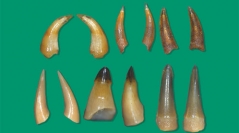

 Comptes Rendus Palevol
21 (43) - Pages 939-968
Comptes Rendus Palevol
21 (43) - Pages 939-968The Neogene of Kutch, India is well known for its rich marine and terrestrial vertebrate assemblages. However, the data of piscean fauna from the middle Miocene of India is very scarce. We report here additional chondrichthyan and osteichthyan remains from the middle Miocene deposit of Chhasra Formation, Palasava site, Kutch, Gujarat, India. The elasmobranchs include Carcharhinus Blainville, 1816 (C. brevipinna (Müller & Henle, 1839), C. falciformis (Müller & Henle, 1839), C. cf. leucas, C. aff. perezi, Carcharhinus sp.), Negaprion Whitley, 1940 (Negaprion sp.), Aetobatus Blainville, 1816 (Aetobatus sp.), Myliobatis Cuvier, 1816 (Myliobatis sp.), Dasyatis Rafinesque, 1810 (D. probsti Cappetta, 1970, D. rugosa Probst, 1877), Himantura Müller & Henle, 1837 (H. menoni Sahni & Mehrotra, 1981), Pastinachus Rüppell, 1829 (Pastinachus sp.), and Taeniurops Garman, 1913 (Taeniurops sp.). The teleosts of Palasava are represented by four families including Bagridae Bleeker, 1858, Channidae Fowler, 1934, Characidae Latreille, 1925 and Cyprinidae Cuvier, 1817. Sørensen-Dice coefficient data of Palasava elasmobranchs show a good similarity index with their counterparts in the Mediterranean Sea suggesting the existence of short-lived reopening of the marine pathway. However, a much higher faunal affinity with those of Eastern Pacific indicates a gradual shift in migration path through the Pacific Ocean to Indo-Pacific region after the permanent landbridge was formed. The vertebrate fauna from the Palasava suggests a coastal, marginal marine, near-shore littoral to neritic environment of deposition with the influence of freshwater riverine system. The integration of the floras and faunas from Palasava locality indicates the presence of warm, humid/wet, tropical to sub-tropical environmental conditions during the middle Miocene.
India, Kutch, middle Miocene, sharks, batoids, paleoenvironment, paleobiogeography